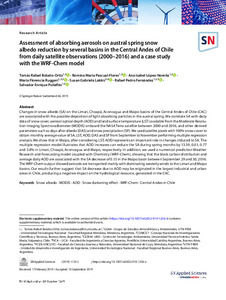Por favor, use este identificador para citar o enlazar este ítem:
https://repositorio.uca.edu.ar/handle/123456789/9286| Título: | Assessment of absorbing aerosols on austral spring snow albedo reduction by several basins in the Central Andes of Chile from daily satellite observations (2000–2016) and a case study with the WRF‑Chem model | Autor: | Bolaño Ortiz, Tomás Rafael Pascual Flores, Romina M. López‑Noreña, Ana Isabel Ruggeri, María F. Lakkis, Susan Gabriela Fernández, Rafael Pedro Puliafito, Salvador E. |
Palabras clave: | ALBEDO; AEROSOLES; NIEVE; METEREOLOGIA | Fecha de publicación: | 2019 | Editorial: | Springer Nature | Cita: | Bolaño Ortiz, T.R. Assessment of absorbing aerosols on austral spring snow albedo reduction by several basins in the Central Andes of Chile from daily satellite observations (2000–2016) and a case study with the WRF‑Chem model [en línea]. SN Applied Sciences. 2019, 1:1352 doi:10.1007/s42452-019-1256-z Disponible en: https://repositorio.uca.edu.ar/handle/123456789/9286 | Resumen: | Abstract: Changes in snow albedo (SA) on the Limari, Choapá, Aconcagua and Maipo basins of the Central Andes of Chile (CAC) are associated with the possible deposition of light-absorbing particles in the austral spring. We correlate SA with daily data of snow cover, aerosol optical depth (AOD) and land surface temperature (LST) available from the Moderate Resolution Imaging Spectroradiometer (MODIS) onboard the NASA Terra satellite between 2000 and 2016, and other derived parameters such as days after albedo (DAS) and snow precipitation (SP). We used satellite pixels with 100% snow cover to obtain monthly average value of SA, LST, AOD, DAS and SP from September to November performing multiple regression analysis. We show that in Maipo, after considering LST, AOD represents an important role in changes induced to SA. The multiple regression model illustrates that AOD increases can reduce the SA during spring months by 13.59, 0.01, 0.77 and 3.8% in Limari, Choapá, Aconcagua and Maipo, respectively. In addition, we used a numerical prediction Weather Research and Forecasting model coupled with Chemistry (WRF-Chem), showing that the black carbon distribution and average daily AOD are associated with the SA decrease of 0.15 in the Maipo basin between September 29 and 30, 2016. The WRF-Chem output showed aerosols are transported mainly with dominating westerly winds to the Limari and Maipo basins. Our results further suggest that SA decrease due to AOD may be originated in the largest industrial and urban areas in Chile, producing a negative impact on the hydrological resource, generated in the CAC. | URI: | https://repositorio.uca.edu.ar/handle/123456789/9286 | ISSN: | 2523-3963 (impreso) 2523-3971 (online) |
Disciplina: | INGENIERIA AMBIENTAL | DOI: | 10.1007/s42452-019-1256-z | Derechos: | Acceso abierto | Fuente: | SN Applied Sciences. 2019, 1:1352 |
| Aparece en las colecciones: | Artículos |
Ficheros en este ítem:
| Fichero | Descripción | Tamaño | Formato | |
|---|---|---|---|---|
| assessment-absorbing-aerosol-austral-spring.pdf | 5,6 MB | Adobe PDF |  Visualizar/Abrir |
Visualizaciones de página(s)
158
comprobado en 27-abr-2024
Descarga(s)
213
comprobado en 27-abr-2024
Google ScholarTM
Ver en Google Scholar
Altmetric
Altmetric
Este ítem está sujeto a una Licencia Creative Commons

